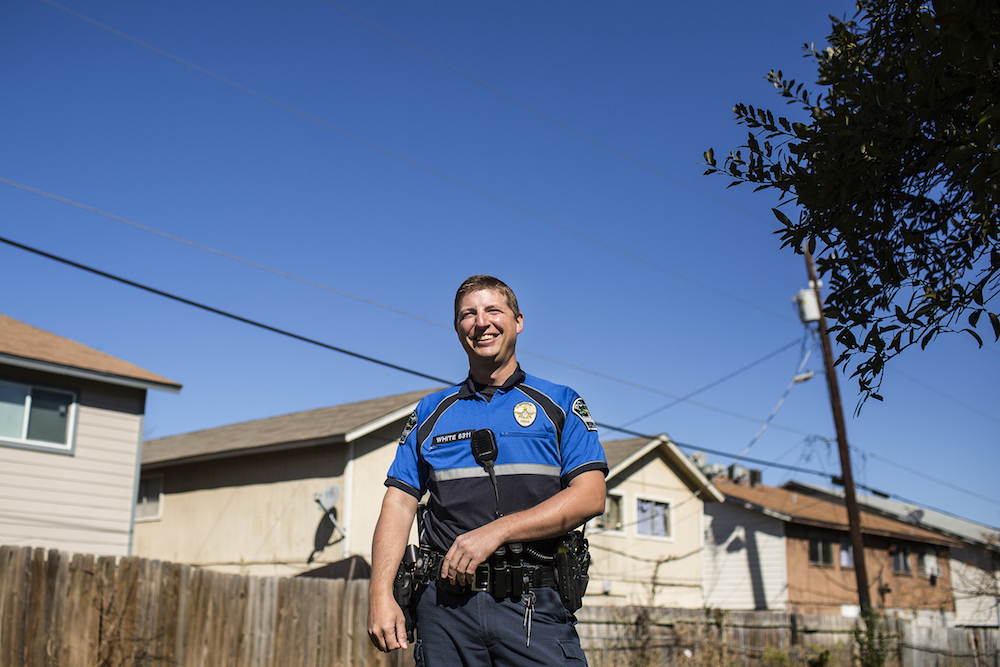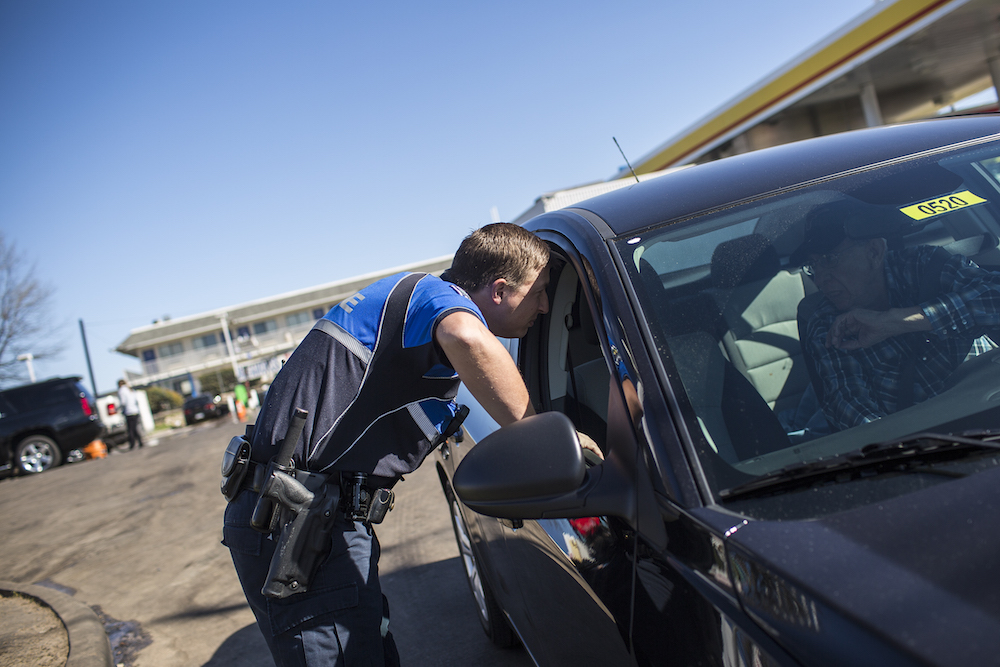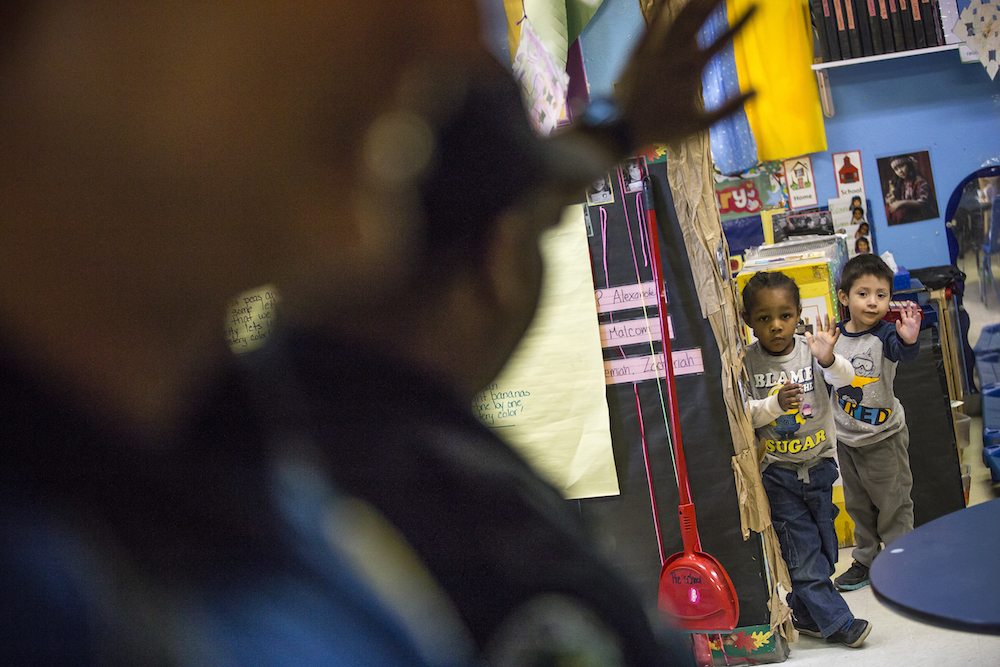How community policing is changing a North Austin neighborhood
On a bright winter morning, Officer Taber White watches as two squad cars pull up on the opposite side of North Austin’s busy Rundberg Ln., lights flashing and sirens shrieking. The police officers jump out of their cars and move to surround their target: a large black-and-tan German Shepherd trotting across the front yard of a faded-orange Austin bungalow.
From across four lanes of traffic, White watches his colleagues trying to get the dog but, other than a quick wave, he doesn’t get involved. He’s in Rundberg on other business.
The Mobile Walking Beat
White and his partner Officer Ray Kianes are part of the Mobile Walking Beat, a special unit of the Austin Police Department that operates exclusively in Rundberg and is spearheading the city’s efforts to confront the area’s historically high crime rates.

As many as eight Mobile Walking Beat officers regularly ditch their squad cars and spend the day doing exactly what their title suggests: walking. They are the foundation of an APD’s community policing pilot project named Restore Rundberg (watch a video about the project).
“It’s really driven by the community policing philosophy,” says social work researcher David Springer.
Springer has contributed to the Restore Rundberg project since 2013, doing everything from measuring and reporting its impacts to helping to build a coalition of city government and nonprofit and neighborhood actors to bolster APDs increased activity in the area. (Watch a video about other School of Social Work initiatives within the Restore Rundberg project).
“The theory is that as officers are out of their patrol cars and walking around in the hotspots of crime, they can approach people that are in the streets and just to get to know them,” Springer continues. “As they develop trust and relationships, residents are more likely to work collaboratively with APD to problem-solve, to report crime, to even come up with solutions that we haven’t thought of before.”
Three days a week, the Mobile Walking Beat walks up and down neighborhood’s thoroughfares like Rundberg Ln. and North Lamar Blvd. The officers pop in and out of the gas stations and hole-in-the-wall restaurants that line the roadside, wind through hilly residential blocks dotted with humble homes and the odd one- and two-story apartment complex, and all the while they chat with the neighborhood residents that they encounter along the way, trying to build relationships with them and always asking “Do you feel safe?”
“Instead of using numbers, arrests, or citations, as our baseline for how successful we were, we decided to just ask people how safe they felt,” says White.
“If they do feel safe, we say ‘ok, great,’ and then we can follow up with ‘Do you have any suggestions? Anything that could be better?” he continues. “And if the answer was ‘No, I don’t feel safe,’ then we absolutely want to know why that is.”
Restore Rundberg: challenges and results
According to Springer’s research, when the project began, only 40 percent of Rundberg’s residents responded they felt safe when polled. Nowadays, that number is closer to 75 percent.
Before 2012, when APD won a $1 million, three-year grant from the U.S. Department of Justice to fund Restore Rundberg, the neighborhood, which is 68 percent Hispanic, made up less than 5 percent of the city’s population but accounted for more than twice as much of its crime.
Since then, both violent and property crime in the area have dropped, with reductions of violent crime of up to 45 percent in the most beleaguered parts of the neighborhood and approximately 15 percent reductions in both property and violent crime across the targeted hotspots of crime.
A little further down Rundberg Ln., an elderly neighborhood resident calls White over to his black/blue Chevrolet sedan. The man thinks he’s seen some suspicious activity near a motel just up the road, and wants to be sure that the police are aware of it.

White is polite and respectful to the man — interactions like this are the bread-and-butter of community policing — but he already knows all about the problems at the motel.
Vagrancy, prostitution, drug dealing: the motels along the strip of I-35 that cuts through Rundberg have been a persistent issue for the at least the past several years.
On more than one occasion, APD has dedicated considerable resources to surveilling the locations both day-and-night in order to crack down on illegal activity. But within months the problems return.
“What do you do with these problems that can’t be fixed with an arrest?” Officer White asks, waving goodbye to the man in the car. “Say, the homeless issue.”
“There was a property over here where a third of our violent crimes — we’re talking about sexual assaults, murders, aggravated assaults, aggravated robberies — a third of our violent crimes were happening right over here on this vacant piece of property,” says White pointing down Rundberg Lane. “The homeless were represented in a very large number of those crimes.”
In vast majority of cases, however, when there’s no evidence that an individual homeless person was involved in a specific crime, there is little that White or any other APD officer can do. Officers can issue tickets for vagrancy or arrest a homeless person for trespassing. But that is rarely enough to deter future infractions and it ties up the officer with paperwork, taking him away from the very community in need of policing. As for breaking up homeless encampments, that simply pushes the problem elsewhere.
To address these persistent issues, the project leadership has created the Rundberg Revitalization Team. Representatives of neighborhood associations, the Austin Independent School District, nonprofit and NGO organizations, the local faith-based community, social workers, health workers, and city officials coordinate with APD and work together to come up with solutions to problems that the police can’t address on their own.
That was the case, for instance, with an entrenched homeless encampment just east of I-35 and Rundberg. Instead of a quick but short-lived fix through arrests, APD partnered with local nonprofits to provide needed relocation and mental health services to the individuals in the encampment.
“It took a little bit longer,” says White, “but, unlike a lot of the other initiatives that you see sometimes a lot, it hasn’t come back.”
A hotspot on Sam Rayburn Drive
White and Kianes spend about an hour strolling up and down a block on Rundberg Ln., chatting with folks at the bus stop, hanging out in a convenience store at a gas station, and eyeing the freeway overpass near where the homeless encampment had been. After that, they head to another hotspot on Sam Rayburn Drive, a one-block cul-de-sac that they describe as the one-time “the most dangerous block in Austin.”
The street has a couple of small apartment complexes and some colorfully painted houses. Only ten days prior, a transgender woman named Monica Loera was shot and killed there.
Bordering the street, there is a lot the size of a city block dotted with young oak trees.
“This was a vacant property where we were having a lot of crime issues,” says White. “A place that was being dumped on, there were couches out here where prostitutes and drug addicts were doing their dirty work…. There were a lot of really bad things going on over here.”
When the Mobile Walking Beat started, APD made a priority to clean up the lot. Since then, the city has allocated $500,000 to convert it into one of Rundberg’s few parks.
On this day, the biggest infraction in sight is about ten empty beer cans that have been tossed over the fence from a neighboring house.
Frustrated but not entirely surprised, White and Kianes walk back up Sam Rayburn Drive to look for the perpetrators — not to arrest or fine them, just to ask them to stop and also to take advantage of the interaction to ask them how safe they feel. Nobody seems to be at home, so the two officers agree to come back on their next shift the following week.
In spite of the Mobile Walking Beat’s success, APD may have to cut back on officer-hours dedicated to the Restore Rundberg project. The Department of Justice funding for Springer’s research ended in November 2015, and the funding for the walking unit will end September of this year.
“One of the lingering questions for everyone in this project is around sustainability,” says Springer. “I think Restore Rundberg has to continue to look for ways through either city funds or additional grant funds to support the work that’s being done.”
After checking on the house, White and Kianes walk to a nearby brightly painted daycare with children laughing and playing in the backyard. The two officers go inside to say hello.

Candi Massey, a soft-spoken woman with a blue pen sticking out of her hair, greets them. She has been working as a teacher at the daycare for the last five years.
“Hey guys, guess who I have out here?” She calls to a group of Pre-K kids running around a room decorated with Disney movie paraphernalia.
“Guess who I have? I have two policemen here. You want to say h’ to them?,” she continues.
After an initial set of excited “Hi”s, Kianes goes through something of a ritual with the kids:
“How is everybody today?” he asks.
“GOOD!” responds the chorus.
“You guys behaving yourself? You being good?” Kianes asks.
“YES!” they all answer.
“My mommy likes policemen!” pipes up one of the kids.
“Your mommy likes policemen?” Kianes echos back.
“I have a movie about Spiderman!” adds another of the kids.
“You have a movie about Spiderman?” Kianes repeats. Then, waving “You guys take care, bye.”
“BYE!”
Out in the hallway, Massey chuckles at the exchange.
“It seems to be getting better,” she says. “We did have that incident the other day,” she says referring to the Loera murder, “but we haven’t had any incidents here. It’s been really good.”
By Martin do Nascimento
